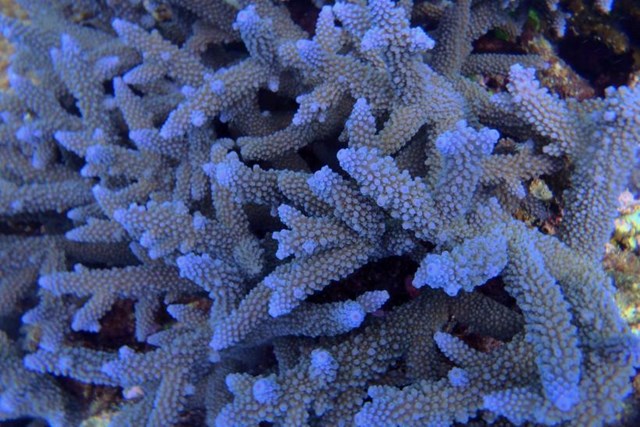
Acropora coral less than 2 meters under sea-level at One Tree Reef, One Tree Island in the southern Great Barrier Reef. (Photo: University of Sydney)
A recent report said that hurricanes devastated coral reefs in the Caribbean and scientists studied their recovery ability from natural disaster. As scientists understand the importance of coral reefs to an ocean ecosystem, conservation efforts have been gathering steam. According to a UNESCO study in June 2017, World Heritage coral reefs could become extinct by 2100 unless CO2 emissions are reduced.
Now, scientists have figured out a new way to study the health of a coral reef system that could help protect them. They've developed a genetic barcode to count populations of larvae in a coral reef ecosystem which gives them a tool for monitoring the health of reef ecosystems.
A team of scientists from the Weizmann Institute of Science , Tel Aviv University and Ben Gurion University used genetic barcoding of nearly 80 percent of the fish species in the Red Sea's Gulf of Aqaba (between Eilat and Aqaba) by sampling several larvae caught twice a month for a year to accurately calculate how many of each species of larvae were swimming around, at what time of year and at what depths. .
The team used a vessel to capture over 10,000 larvae in 400 different samples and created a map that could tell different species apart and how many could be found, at what time of year, at which particular location and depth.
"Understanding the types and distribution of the larvae is important for a number of reasons," said Prof. Roi Holzman from the Interuniversity Institute for Marine Sciences (IUI) in Eilat.
Larvae are an integral part of the ecosystem since their numbers can reveal the prospective populations of adult fish in a reef system.
Traditionally to study larvae, scientists count their spines under a microscope, but the team developed a new method that involves sequencing a gene barcode from the adult fish of the same species to identify the larvae of the same species.
“We had to create a database of ‘barcodes’ for all the reef fish in the gulf. That was a feat in itself. For it, the team members took up diving in the gulf to clip the fins of adult fish for DNA analysis. Ultimately, we managed to create a database of barcodes for around 80 percent of the main fish species (420 of about 540) known to frequent the reef,”said Prof. Rotem Sorek from the Weizmann Institute of Science in a press release on their website.
All of the fish DNA in each sample was sequenced together and were then matched to the DNA sequence of the larvae which told them exactly how many individual larvae of each species were in the sample. Their barcode method allowed them to analyze thousands of larvae at a finer resolution.
“Because we could now analyze thousands of larvae at a much finer resolution than was previously possible,” said Prof. Moshe Kiflawi, “ we could now zoom in on ecological differences between species. If the larvae of one family of fish had been presumed to live in both shallow and deep waters, we could now see that some species in the family prefer the shallow waters, while others prefer deeper waters – a difference that can affect their survival and dispersal.”
The team found that this method could accurately show the invasion of several fish species into the Mediterranean like the puffer fish known as a Spiny blaasop and also give them an accurate picture of how healthy the reef system is based on the species diversity and the rate of reproduction in the fish living there.
“Although the initial process was a bit arduous, we now have an excellent tool for monitoring the health of the reef ecosystem, and other reef researchers may follow suit, ” Kiflawi added.
The study was published in journal Ecology and Evolution Dec.18.
